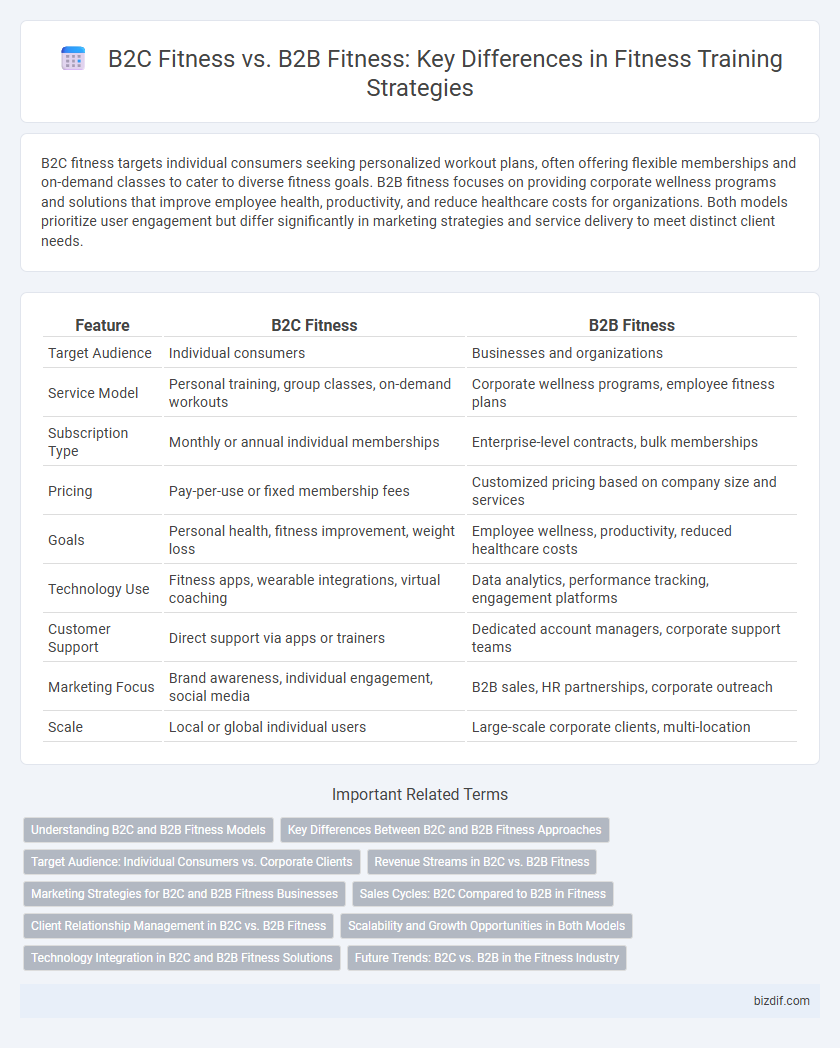B2C fitness targets individual consumers seeking personalized workout plans, often offering flexible memberships and on-demand classes to cater to diverse fitness goals. B2B fitness focuses on providing corporate wellness programs and solutions that improve employee health, productivity, and reduce healthcare costs for organizations. Both models prioritize user engagement but differ significantly in marketing strategies and service delivery to meet distinct client needs.
Table of Comparison
| Feature | B2C Fitness | B2B Fitness |
|---|---|---|
| Target Audience | Individual consumers | Businesses and organizations |
| Service Model | Personal training, group classes, on-demand workouts | Corporate wellness programs, employee fitness plans |
| Subscription Type | Monthly or annual individual memberships | Enterprise-level contracts, bulk memberships |
| Pricing | Pay-per-use or fixed membership fees | Customized pricing based on company size and services |
| Goals | Personal health, fitness improvement, weight loss | Employee wellness, productivity, reduced healthcare costs |
| Technology Use | Fitness apps, wearable integrations, virtual coaching | Data analytics, performance tracking, engagement platforms |
| Customer Support | Direct support via apps or trainers | Dedicated account managers, corporate support teams |
| Marketing Focus | Brand awareness, individual engagement, social media | B2B sales, HR partnerships, corporate outreach |
| Scale | Local or global individual users | Large-scale corporate clients, multi-location |
Understanding B2C and B2B Fitness Models
B2C fitness models prioritize individual consumers, offering personalized workout plans, on-demand classes, and membership subscriptions tailored to personal goals and preferences. B2B fitness focuses on corporate clients, providing employee wellness programs, group training sessions, and fitness solutions designed to improve workplace health and productivity. Understanding these models helps businesses optimize marketing strategies and service offerings, enhancing user engagement and retention in both sectors.
Key Differences Between B2C and B2B Fitness Approaches
B2C fitness targets individual consumers through personalized training programs, emphasizing motivation, convenience, and lifestyle integration to boost retention and satisfaction. B2B fitness focuses on organizational clients, offering scalable wellness solutions, corporate partnerships, and tailored employee health initiatives that prioritize productivity and group engagement. Marketing strategies diverge as B2C leverages direct emotional appeal and social proof, while B2B relies on data-driven value propositions and long-term contract relationships.
Target Audience: Individual Consumers vs. Corporate Clients
B2C fitness targets individual consumers seeking personalized workout plans, gym memberships, and wellness products tailored to their unique health goals. B2B fitness focuses on corporate clients, offering employee wellness programs, group fitness classes, and customized health initiatives to improve workforce productivity and reduce healthcare costs. Understanding the distinct needs of each audience enables fitness providers to design effective engagement strategies and maximize customer satisfaction.
Revenue Streams in B2C vs. B2B Fitness
B2C fitness revenue streams primarily derive from individual memberships, personal training sessions, and on-demand digital content subscriptions, generating consistent cash flow through high volume and recurring payments. B2B fitness revenue focuses on corporate wellness programs, bulk membership sales to companies, and partnerships with health insurers, offering larger but less frequent contract payments. Understanding these distinct revenue models enables better financial planning and targeted marketing strategies tailored to each sector's unique client base.
Marketing Strategies for B2C and B2B Fitness Businesses
B2C fitness marketing strategies focus on emotional engagement, personalized experiences, and social media influence to attract individual consumers seeking motivation and community. In contrast, B2B fitness marketing targets corporate wellness programs, leveraging data-driven ROI presentations and strategic partnerships to appeal to businesses aiming to enhance employee health and productivity. Tailoring content for each audience--emphasizing personal transformation for B2C and measurable benefits for B2B--maximizes customer acquisition and retention in the competitive fitness industry.
Sales Cycles: B2C Compared to B2B in Fitness
B2C fitness sales cycles are typically shorter, driven by immediate consumer motivation and impulse decisions for memberships or personal training sessions. B2B fitness sales cycles often extend over weeks or months, involving detailed contract negotiations, multiple stakeholders, and tailored service packages for corporate wellness programs. Understanding these differences helps optimize sales strategies to either accelerate decision-making in B2C or build relationships and trust in B2B markets.
Client Relationship Management in B2C vs. B2B Fitness
Client Relationship Management (CRM) in B2C fitness prioritizes personalized engagement through apps, social media, and tailored workout plans to enhance individual member retention and satisfaction. In contrast, B2B fitness CRM involves managing corporate accounts, coordinating bulk memberships, and delivering scalable wellness programs to meet organizational health goals. Effective CRM systems in both sectors utilize data analytics to optimize client communication and improve service offerings.
Scalability and Growth Opportunities in Both Models
B2C fitness models leverage direct consumer engagement and personalized programs, enabling rapid scalability through digital platforms and social media marketing. B2B fitness focuses on partnerships with corporations and institutions, offering bulk service contracts and employee wellness programs, which provide stable revenue streams and long-term growth potential. Both models benefit from technology integration, but B2B's scalability often depends on contract acquisition, while B2C growth thrives on user acquisition and retention strategies.
Technology Integration in B2C and B2B Fitness Solutions
B2C fitness solutions emphasize technology integration through personalized apps, wearable devices, and on-demand virtual classes that enhance user engagement and track individual progress. In contrast, B2B fitness platforms focus on scalable technology infrastructure, including gym management software, corporate wellness analytics, and employee fitness tracking systems to optimize operational efficiency and promote workplace health. Both sectors leverage AI and data analytics, but B2C targets consumer experience while B2B prioritizes organizational fitness ecosystem optimization.
Future Trends: B2C vs. B2B in the Fitness Industry
B2C fitness is evolving toward personalized digital experiences using AI-driven apps and wearable technology that enhance user engagement and motivation. B2B fitness increasingly integrates corporate wellness programs with advanced analytics and virtual training platforms to boost employee health and productivity. Both sectors are converging on hybrid models combining in-person and remote workouts, leveraging data to tailor fitness solutions for end-users and organizations alike.
B2C Fitness vs B2B Fitness Infographic

 bizdif.com
bizdif.com